Content tagged book
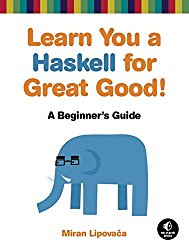
This is the first book on Haskell, that really made me want to read it.
I had it with me as an e-book on my vacations. I couldn't stop reading
it before I finished. It is a very good introduction to the basics of
the Haskell programming language. It even contains an understandable
explanation of the infamous monads. (Side note: they are a very simple
concept, and you shouldn't fear them.)
For me this book was the right amount of introduction to get me started.
Everything else I think I will be able to learn while using the language.
The book is available in print at your preferred book shop, or
can be read online and free of charge.
Links to resources
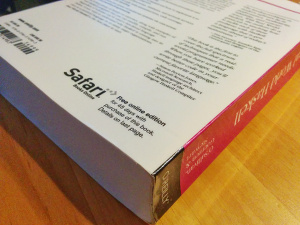
I like the books from O'Reilly. For many years I've seen the ad on the
backside advertising Safari. Sure, I checked out what this is, but I
wasn't really interested to have a digital copy for a limited amount of time.
I already had the print version.
I love to read real books made of paper. I use highlighters and add
notes, while reading. I make the book mine. And after finishing the book, I can
place it on my bookshelf, to show the books I like to others. This doesn't work
with my Tolino e-book reader. While I have this device,
I still buy most books as a paper copy.
Some days ago, I heard of Safari again on a podcast. I thought, that at least I
should check it out. It's not only O'Reilly books anymore and it includes videos
and other podcasts as well. There is a free 10 days trial, so I did not have to
invest more than some of my time.
weiterlesen | read more | lee mas | lê mais | 閱讀更多 »
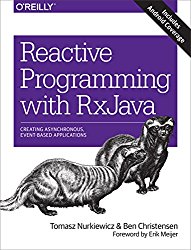
RxJava is an implementation of “Reactive Extensions” (Rx) in Java. But what is
this? Originally Rx are an implementation of Microsoft to address the
increasing complexity of software. It is a model to build large scale
asynchronous service architectures.
Another company that has to be mentioned is Netflix: they implemented the
Rx in Java which resulted in RxJava.
On the programming side Rx looks very similar to how streams
(java.util.stream.Stream) work. The main difference in my opinion is that
streams are pull and lazy. They produce only as much data as someone is reading
from them. RxJava on the other side is more push style. The source of data is
pushing events through a pipe of operators similar to what you know from streams
(filter(), map(), and so on) to the sink. And as I know from this book, Java
streams are the wrong tool to parallelize anything that is not CPU bound–like
network requests. There reason for this is, that (parallel) streams are executed
on a thread pool that is shared with several other features of Java. This thread
pools is limited to have only that many workers as the system has CPU
cores. Therefore this pool gets exhausted very soon, when threads in it get
blocked by I/O operations. Any thread waiting for an I/O operation effectively
results in a processor core not used by your program.
RxJava on the other hand is not limited to a fixed thread pool. Any source
(Observable) and sink (Subscriber) of data can be bound declaratively to
user defined Schedulers. As well as Rx favours a model in which I/O
operations are done asynchronously and non-blocking. Therefore resulting in a
need for much fewer threads. In a traditional model of using one thread per
network connection, threads become very soon the first thing that limits
scalability.
What is really great about this book
The best part of this book for me were the reflections on Relational Database
Access in chapter 5. While as a developer you might be tempted to convert
everything to the reactive model, this part of the book shows where it doesn't
make sense to do so.
By converting the access to your relational database to an asynchronous model
you won't gain anything. Whatever you are doing on the client side, let's say
for example your PostgreSQL will run all of your concurrent requests in
different processes. This results in a noticeable limit on the number of
parallel queries you're able to run. You cannot lift this limit by becoming
asynchronous on the client side.
Links to the book
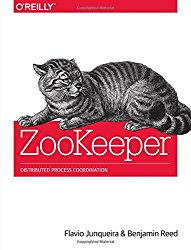
ZooKeeper is a component that facilitates building distributed applications.
It is:
- a distributed hierarchical key value store,
- chooses C(onsistency) and A(availability) in the CAP theorem,
- works best on read-dominated workloads (< 10% writes),
- keeps content in the memory of each instance, and
- expects the data stored on each node (key) to be small (maybe several KiB).
The data managed by ZooKeeper is presented in a file system like manner with
directories and files whose names get separated by slashes (/). The difference
to a file system is, that you can store information in the directories as well.
Or seen differently: directories are files at the same time. Based on this
simple abstraction, users of ZooKeeper can implement things like leader election
in a cluster of software instances.
weiterlesen | read more | lee mas | lê mais | 閱讀更多 »
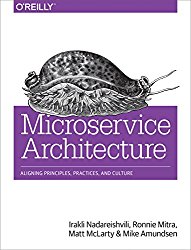
To stay on the right track with microservices, I wanted to revisit the
philosophy and organizational recomendations on how to do them right. After
reading Building Microservices in april this year, I
got Microservice Architecture, aligning principles, practices, and culture by
Irakli Nadareishvili et al.; O'Reilly Media, Inc., 2016.
The book can be read on one week-end as the content is very well condensed to
118 pages.
weiterlesen | read more | lee mas | lê mais | 閱讀更多 »

It's hard to find sources how to do front-end micro-services in a single page
application (SPA). Having a single front-end that faces the user
makes it hard to impossible to exploid the full power of going micro-services in
the back-end. For every new function you cannot just deploy the corresponding
service, but you have the dependency to update and redeploy the service as well.
So I was looking around how to go micro in an SPA. One of the ideas
I found on the web was to do so using web components. To evaluate this idea as
someone working mainly on the backend I thought I should get some literature and
bought the book Developing Web Components by Jarrod Overson and Jason Strimpel,
O'Reilly Media, Inc., 2015.
weiterlesen | read more | lee mas | lê mais | 閱讀更多 »

Die letzten Tage habe ich das Buch ARM Assembly Language – an
Introduction von J. R. Gibson
gelesen. Es ist eine Anleitung wie man ARM-Prozessoren in Assembler
programmiert. Geschrieben wurde das Buch als Lehrbuch an der Universität
Liverpool. Das merkt man, am Ende jeden Kapitels stehen Übungsaufgaben zum
Einprägen und Verständnis überprüfen.
Das Buch ist perfekt für Einsteiger in der Assemblerprogrammierung. Der Leser
erhält einen ausführlichen Überblick wie er in dieser Sprache programmieren
kann. Wird der Einstieg mit einer begleitenden Vorlesung und Übungen
unterstützt, so funktioniert das Buch noch besser. Es hilft aber auch, ein paar
Grundlagen der Zahldarstellung und der Bit-Manipulation schon zu kennen.
Im Buch wird die ARM-7-Architektur behandelt. Vor allem wird der Prozessor
ARM7TDMI betrachtet. Details zu den Prozessoren oder anderer Hardware findet man
aber nicht. Dadurch ist das Buch auf für die allgemeine ARM-Programmierung
interessant. Wer allerdings die Cortex-M-Prozessoren programmieren möchte, hat
mit diesem Buch nicht das richtige. Es behandelt nicht die THUMB-Befehle, die
der Cortex-M ausschließlich unterstützt.
Meine Bewertung: 5 von 5 Punkten für den Leser, der Assembler auf einem
ARM-Prozessor lernen möchte und motiviert sind auch die Übungsaufgaben zu
bearbeiten. Lesen alleine reicht nicht aus.

Endlich wissen was in C++11 neu ist, deswegen habe ich „C++11, Der Leitfaden
für Programmierer zum neuen Standard” von Rainer
Grimm gelesen. Ein dickes Buch mit
500 Seiten beschreibt was sich in der neuen Version seit 1998 geändert hat oder
neu ist. – Und das ist eine Menge.
Immer wieder war ich erstaunt über ungewöhnliche neue Konstrukte und neue
Syntax. Solch große Änderungen hatte ich einer reifen Sprache nicht
zugetraut. Meine Highlights in C++ sind:
- C++ iteriert Container jetzt mit einer for-each-Schleife. In neueren Sprachen
für uns schon lange Standard, können wir dies auch in C++11 nutzen;
- mit Lambda-Funktionen unterstützt uns C++ jetzt in der funktionalen
Programmierung – das funktioniert auch mit Templates;
- ganz verrückt sind rvalue-Referenzen und die Move-Semantik, übergebene Werte
werden nicht kopiert sondern zum Empfänger verschoben (das heißt wer das
Objekt in einem Funktionsaufruf übergibt hat es hinterher nicht mehr);
- ganz besonders mag ich, die neuen Datentypen wchar16_t und wchar32_t für
UTF-16 und UTF-32, im gegensatz zum bisherigen wchar_t wurde hier explizit
die Datenbreite definiert (wchar_t unter Linux hat 32 Bit, unter Windows nur
16 Bit);
- reguläre Ausdrücke existieren endlich auch in C++ und
- Smartpointer wurden sehr viel handlicher und einfacher zu verwenden.
Sehr mutig ist die Spezifikation auch weil sie eine neue Syntax für Funktionen
einführt. Bisher definieren wir eine Funktion in der Reihenfolge „Rückgabetyp,
Funktionsname und Parameterliste“. In C++ können wir den Rückgabetyp auch
hinter die Parameterliste schreiben:
auto fac(int n) -> int {
return n > 0 ? n * fac(n - 1) : 1;
}
Rainer Grimm geht die Änderungen leicht verständlich an: in drei Durchgängen
zeigt er zuerst nur was es neues gibt, im zweiten geht er weiter in die Tiefe
der Erweiterungen und im dritten geht er ins Detail. Er Leser kann sich so
schnell einen Überblick verschaffen und stolpert in den Details nicht darüber,
wenn in Beispielen auch eine andere Neuerung als die gerade erklärte schon
benutzt wird. Einziges Manko: im dritten Durchgang bei den Details wurde mir
etwas langweilig. Trotzdem ein großartiges Buch dem ich vier von fünf Punkten
gebe.









